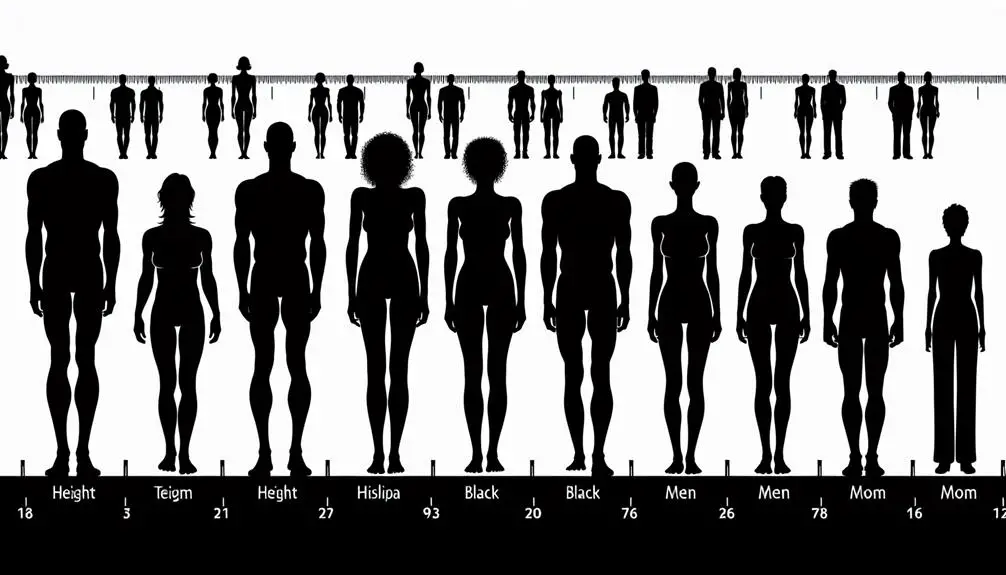Ever wondered how your shoulder width compares to your height? It's fascinating to discover how these measurements interplay to create our unique body proportions.
But have you ever thought about the significance of knowing your average shoulder width for your height in practical terms? Understanding this relationship can have surprising implications for how clothes fit, how ergonomic products are designed, and even how balanced our overall body proportions appear.
So, let's explore this often-overlooked aspect of our anatomy and its impact on our everyday lives.
Table of Contents
Key Takeaways
- Shoulder width varies with height, influencing proportions and clothing fit.
- Genetics, skeletal structure, and ethnicity impact average shoulder width.
- Properly fitting clothing enhances appearance, emphasizing the importance of shoulder width.
- Shoulder width modifications through exercises and nutrition can enhance physique and confidence.
Average Shoulder Width Overview
Shoulder width serves as a crucial anthropometric measurement in assessing body proportions and designing tailored clothing. When it comes to body measurements, the shoulder width for men typically averages at least 16 inches in the United States, while for women, it's at least 14 inches.
From the data collected between 1988 and 1994, the average shoulder width in the U.S. was 14.4 inches for women and 16.1 inches for men, showcasing a trend towards broader shoulders over the years. Interestingly, the average shoulder width in Sweden in 2009 differed, with men measuring around 15.5 inches and women at 14 inches, highlighting variations across regions.
Understanding shoulder width isn't merely about aesthetics; it plays a significant role in research, design, and even health trends. With men's average shoulder width on the rise, accurate measurements are vital for clothing sizing, tailoring, and various design applications, reflecting changes in body proportions and health patterns.
The shoulder-to-waist ratio, influenced by skeletal structure and compound movements, is an essential factor in determining overall body symmetry and strength.
Importance of Shoulder Width
Broad shoulders are crucial for achieving a visually pleasing physique and can significantly impact one's overall appearance and confidence. When it comes to body proportions, shoulder width plays a key role in creating a balanced and attractive silhouette. The ideal shoulder width-to-height ratio is essential for achieving a well-proportioned physique and is particularly important for developing the coveted V-taper that enhances aesthetics for both men and women.
Moreover, broad shoulders not only contribute to a more appealing appearance but also play a significant role in improving posture. By enhancing posture, shoulder width can boost confidence levels and give off an impression of strength and athleticism. Understanding the importance of shoulder width concerning your height can aid in setting realistic fitness goals and working towards a physique that's both aesthetically pleasing and proportionate. So, whether you're aiming for a sculpted look or striving to improve your overall fitness, paying attention to your shoulder width is a crucial aspect of your journey.
Average Shoulder Width for Men
Considering the significance of shoulder width in achieving a balanced physique, understanding the average shoulder width for men provides valuable insights into body proportions and aesthetics. When it comes to men's shoulder width, there are some key points to keep in mind:
- The average shoulder width for men is approximately 16.2 inches according to CDC data.
- Men's shoulder circumference averages around 46.25 inches based on research findings.
- Shoulder width remains relatively stable for men between the ages of 20 to 59 years.
Factors such as weight, exercise habits, and genetics can influence variations in men's shoulder width. It's important to note that men's shoulder width plays a role not only in the overall stability of the body but also in how clothing fits and complements their physique. Understanding these average measurements can be beneficial, especially for those looking to enhance their appearance or track their body transformations effectively.
Average Shoulder Width for Women
I'm excited to shed light on the average shoulder width for women, which hovers around 14.4 inches according to CDC data. Factors like height, genetics, and skeletal structure play a role in determining a woman's shoulder width, impacting how clothes fit.
Understanding these nuances is crucial for achieving the right clothing fit, considering body proportions, and ensuring overall health considerations.
Female Shoulder Width Data
On average, adult women have a shoulder width that ranges from 13.4 inches to 18.9 inches. When looking at female shoulder width data, it's fascinating to see the variations that exist.
Here are some key points to consider:
- The average shoulder circumference for adult females is around 39.4 inches, according to a 2016 study.
- Women's shoulder width can vary across different age groups due to factors like genetics and aging.
- The CDC data indicates that the average female shoulder width is approximately 14.4 inches.
Understanding these variations can provide insights into how shoulder width relates to factors such as height and skeletal structure.
Factors Affecting Width
Exploring the factors that influence the average shoulder width for women reveals a complex interplay between height, genetics, and skeletal structure. Women with taller heights generally exhibit wider shoulder widths on average, a trait often influenced by genetic predispositions. Additionally, shoulder width measurements in women are intricately linked to their bone structure and overall body proportions. Understanding how height impacts the average shoulder width in women is crucial for tailored clothing and design considerations. By acknowledging these factors, designers can create garments that fit better and enhance the wearer's silhouette. Here is a breakdown of the key factors affecting shoulder width in women:
| Factor | Influence |
|---|---|
| Height | Taller women tend to have broader shoulders |
| Genetics | Genetic factors play a significant role |
| Skeletal Structure | Bone structure impacts shoulder width |
| Body Proportions | Overall body proportions affect shoulder width |
Clothing Fit Considerations
Considering the average shoulder width for women is crucial in ensuring clothing fits comfortably and flatters their body proportions.
When it comes to clothing fit considerations based on shoulder width and height, here are three key points to keep in mind:
- Measurement Importance: Shoulder width measurements are fundamental for tailoring clothes to achieve a comfortable and flattering fit.
- Choosing the Right Size: Understanding how shoulder width correlates with height helps women select the appropriate clothing sizes and styles that complement their body shape and proportions.
- Enhancing Proportions: By considering shoulder width when choosing tops, dresses, and jackets, women can enhance their overall proportions and feel confident in their attire.
Measuring Your Shoulder Width
To determine your shoulder width accurately, measure from shoulder tip to shoulder tip using a tape measure. This measurement, also known as biacromial width, provides a clear indication of the width of your shoulders. When measuring, ensure the tape is straight and level for precise results. If you need assistance, ask a friend to help measure from one shoulder tip to the other.
Another method involves measuring tricep-to-tricep, offering a different perspective on your shoulder width. You can even measure against a wall, marking the points to streamline the process for future reference.
Combining your shoulder width measurement with other body measurements can be beneficial for various purposes such as tracking fitness progress or selecting well-fitting clothes. Understanding your shoulder width is essential for achieving proper garment fit and assessing overall body proportions accurately.
Factors Influencing Shoulder Width
Influenced by genetics, ethnicity, diet, exercise, and hormonal levels, shoulder width varies among individuals due to a combination of factors. When considering the factors that influence shoulder width, it's crucial to delve into the specifics to understand the intricacies of shoulder breadth.
Here are key elements that play a role:
- Bone Structure: The underlying bone structure sets the foundation for shoulder width, providing a framework that influences the overall breadth.
- Muscle Mass: The development and size of shoulder muscles, particularly the deltoid muscles, contribute significantly to shoulder width variations.
- Soft Tissues: Soft tissues, including muscle and fat thickness, also impact shoulder width measurements, adding complexity to the assessment process.
When looking to obtain an accurate assessment of shoulder breadth, it's essential to consider the interplay of these factors to determine an individual's unique shoulder width profile. Understanding these influences can lead to more precise measurements and insights into shoulder anatomy.
Tips for Modifying Shoulder Width
When aiming to modify shoulder width, incorporating targeted exercises and progressive training methods can effectively enhance shoulder muscle mass and overall breadth. To vary your shoulder width, focus on exercises like lateral raises, shoulder presses, and upright rows to specifically target the deltoid muscles. These movements help increase upper body strength and promote broader shoulders.
Use a measuring tape to track changes in biacromial breadth, the distance between your acromion processes, to monitor shoulder size gains. Incorporating compound exercises such as overhead presses and pull-ups can further boost shoulder development by engaging multiple muscle groups simultaneously. Remember, consistent training and proper nutrition play significant roles in modifying shoulder width.
Consulting with a fitness professional can provide personalized guidance on creating a workout plan tailored to your shoulder width goals based on your body structure.
Frequently Asked Questions
What Is Average Shoulder Width According to Height?
I can't provide a direct average for shoulder width based on height. Many factors affect shoulder width, like genetics and muscle development. Shoulder width varies among individuals of the same height due to unique physical traits.
Are 52 Inch Shoulders Big?
Yes, 52-inch shoulders are big. They indicate significant muscle mass and a broad upper body. Achieving this size requires dedicated strength training. People with such shoulders stand out for their impressive physical presence and muscular development.
Is 18 Inches Wide for Shoulders?
Oh, 18 inches wide for shoulders? That's broad! It's a solid width, giving a strong, athletic look. Achieving it might need exercise, diet, and genetics. Wide shoulders enhance symmetry and masculinity, adding to strength.
What Is the Shoulder Width of a 6ft Man?
For a 6ft man, shoulder width typically ranges from 17 to 19 inches due to factors like genetics and muscle mass. Broad shoulders reflect proportional growth. Clothing sizes often fit around 18 inches, accommodating this average.
- Recycling Nonwoven Fabrics: Is It Possible? - July 11, 2025
- Recycling Nonwoven Fabrics: Is It Possible? - July 11, 2025
- Recycling Nonwoven Fabrics: Is It Possible? - July 11, 2025







